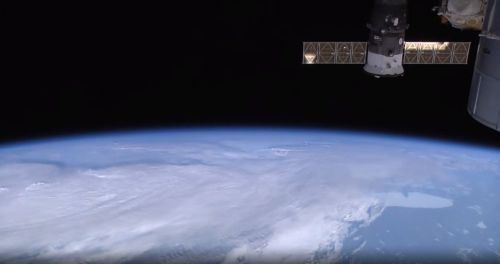
(Photo credit: NASA/Ustream)
As part of a new experiment, NASA have placed four commercial video cameras on the exterior of the International Space Station (ISS).
The Hitachi, Panasonic, Sony and Toshiba cameras were installed in April as part of the High Definition Earth Viewing experiment (HDEV). The experiment will enable NASA engineers to decide on the best technology to use on future missions, as the footage will be analysed to assess how the hardware performs in the space environment. But, the cameras also provide the best idea yet of what it is like to be an astronaut viewing Earth from the ISS. NASA has made the cameras publicly accessible, so anyone can tune in and watch a real-time view of our planet from space.
The experiment reached the International Space Station inside SpaceX’s Dragon capsule on April 20th (to read more about it’s arrival, click here). The resupply spacecraft had launched from Florida atop a Falcon 9 rocket on April 18th, and after the craft had docked to the ISS, the cameras were remotely removed by the Canadian Space Agency’s robotic arm. Teams on the ground then manoeuvred the robotic arm to install the cameras on the Columbus External Payload Facility. 10 days after the experiment arrived at the ISS, HDEV was activated and the cameras began streaming on April 30.

(Photo credit: NASA/Ustream)
The International Space Station moves at 17,100 miles per hour and completes an orbit of Earth every 90 minutes. Therefore you can view a spectacular sunset or sunrise every 45 minutes. However, the footage is not constant as at times the screen can appear black or grey. But don’t be alarmed if the cameras are black, this occurs when the ISS is travelling over a part of the world that is experiencing night time. The cameras are simply looking at the darkened side of Earth, so check back periodically until the station has travelled into daylight. While watching, you might also notice that the screen is grey, this means the cameras are temporarily offline. This takes place when the International Space Station is too far away from a satellite that provides a video downlink with the ground, however the camera feed will return.
The project has been operational for just over 2 weeks and the live stream has already amassed nearly 19 million views. The cameras are expected to remain operational until at least Expedition 44 in October 2015, so if you wish to take part in the HDEV experiment, you can view footage of the Earth alongside a map which depicts the current location of the International Space Station here.